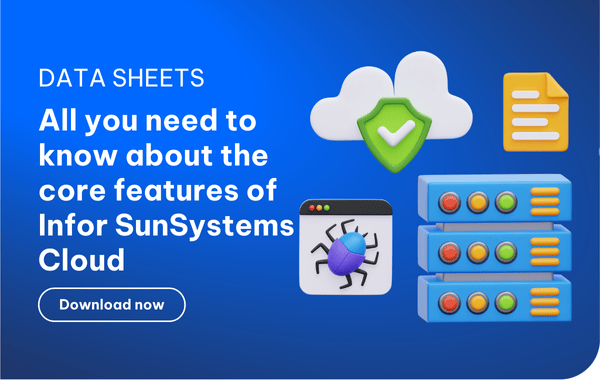Migrating your business data from on-premises infrastructure to the cloud is a big decision that needs serious consideration and a meticulous strategy to avoid interruptions and pitfalls.
To help your transition go smoothly, in this blog, we have compiled six key steps to ensure you get the best results from your on-premises to cloud migration.
Read more: Understanding Different Data Migration Strategies
Content
Why migrating from on-premises to the cloud is necessary?
2. Scalability and flexibility
3. Improved business performance
4. Accelerating digital transformation
2. Evaluate your current on-premises system
3. Develop a migration strategy
4. Select your tool, methodology, and partner
5. Establish a deployment dream team
6. Execute and maintain the plan
7. Evaluation and optimisation
Move your finance system to the cloud with Infor SunSystems Cloud

Why migrating from on-premises to the cloud is necessary?
On-premises-to-cloud migration refers to the process of shifting the digital assets of an organisation from on-site to a cloud-based infrastructure. This can be conducted using various methods, such as directly transferring data to a cloud environment via a network connection (online migration) or indirectly migrating data from available portable storage devices (offline migration).
The transformation can offer enormous advantages to organisations.
Read more: From On-Premises to the Cloud: Understanding Migration Strategies
1. Cost reduction
Maintaining and managing a physical data centre can be a tedious day-to-day task for your IT team. Since cloud providers handle maintenance and upgrades, companies that apply cloud solutions can significantly reduce the costs associated with physical infrastructure and depreciation. Instead of keeping things up and running, companies can devote their time and resources to developing and improving their products.
2. Scalability and flexibility
Cloud providers offer scalable and flexible solutions that can instantaneously adapt to ever-changing needs. With cloud solutions, you can rapidly expand or scale down your business on short notice, depending on your current needs, without worrying about upfront investment costs or wasted capacity. This is particularly helpful for organisations that experience seasonal spikes in demand or are expecting to grow quickly.
Read more: How SaaS Helps Drive Digital Transformation for SMEs
3. Improved business performance
Performance affects more than just your IT team. If your systems are not functioning properly, you risk losing customers. There are two critical components to evaluating successful network performance: low latency and high availability.
A transformation to the cloud can significantly improve both. Digital assets hosted in the cloud can effortlessly scale to satisfy more users’ demands and operate in geographical locations near users to reduce network latency.
4. Accelerating digital transformation
In today’s world, the development of digital technologies and innovation have compelled many organisations to apply digital transformation to their business models in recent years. According to Gartner, 91% of businesses are engaged in some form of digital initiative, and 87% of senior business leaders say digitalisation is a priority.
By migrating their on-premises data to a cloud-based infrastructure, businesses can take advantage of cutting-edge cloud technologies to create incremental value for existing assets, streamline operating processes, and unlock new sources of revenue.
Cloud solutions, such as real-time analytics, data automation, etc., that sync and aggregate data from various sources are powerful and necessary for enterprises to keep up with industry trends and stay ahead of the curve.
Read more: 4 Must-Have Features in Cloud Accounting Software for SMEs
Key steps to switching from an on-premises financial management system to a cloud-based infrastructure
1. Define clear objectives
Establishing clear goals prior to migrating legacy, on-premises financial management solutions to the cloud is imperative for every business embarking on this transformative journey. It helps align the migration process with the overall strategic objectives of the business while ensuring that the organisation's long-term vision and specific needs are driving the cloud migration effort.
More important, identifying goals allows businesses to conduct a thorough need analysis. By understanding the desired outcomes, businesses can evaluate cloud solutions and select the one that best meets their needs. This analysis helps avoid unnecessary features or functionalities that may not align with the organisation's goals.
Read more: Single ERP suite vs. multiple best-of-breed systems
Clear goals act as a guiding framework for decision-making throughout the migration process. When faced with choices regarding cloud providers, deployment models, or system configurations, having defined objectives helps businesses make informed decisions that align with their intended outcomes.
Additionally, goals provide businesses with a basis for effectively allocating resources and measuring success. Organisations can track progress and evaluate whether the migration project has achieved the desired outcomes.
Migrating to the cloud often involves significant changes in processes, workflows, and user experiences. Clearly defined goals help communicate the purpose and benefits of the migration to stakeholders. This facilitates change management by providing a shared understanding of why the migration is necessary and what benefits it will bring.
Overall, determining goals before migrating legacy, on-premises financial management solutions to the cloud provides businesses with a roadmap for success. It ensures that the migration effort is purposeful, aligned with strategic objectives, and focused on achieving specific outcomes that bring value to the organisation.
Read more: 10 Questions to Consider for Successful Financial Management Implementation
Back to the top2. Evaluate your current on-premises system
The first and most important step of this long process involves assessing and evaluating the functionality and limitations of your existing infrastructure. There are some systems developed and optimised only for on-premises use, so sometimes migrating everything at once will not be a viable solution.
Understanding their technical and business requirements will help you determine which systems are suitable for cloud migration, which need to be updated or replaced, and which can remain on-premises.
During this process, companies should thoroughly weigh both the pros and cons of transferring their current resources to the cloud, identify any shortcomings in skills and technologies that might need to be addressed, and understand potential risks that can arise before executing the migration.
Read more: How AWS Manages and Maintains Their Massive Data Centres
Back to the top3. Develop a migration strategy
Before conducting any migration, a detailed plan for transferring digital assets is necessary to ensure a smooth process and reduce unexpected catastrophes that arise along the way. To better monitor and follow the progress, a standard plan should include a roadmap for execution, a cost allocation structure, and KPIs.
Understanding the performance under available resources and costs is vital to making informed decisions. You need to analyse the expenses associated with purchasing, operating, and maintaining local servers and how much they contribute to your overall business expenses. Subsequently, compare your costs and performance indicators between on-premises and cloud platforms.
Read more: 8 Strategies to Sidestep Financial Software Implementation Pitfalls
4. Select your tool, methodology, and partner
When choosing an appropriate cloud solution, vendor, and deployment method, it is important to consider your specific business model and requirements. Every organisation is unique; what works for one may not necessarily work for another. That is why taking the time to evaluate your needs and goals is essential.
However, not every organisation has the necessary expertise and technical skills to conduct the migration themselves. This is where choosing the right partners becomes crucial. Collaborating with experienced and reliable cloud providers can make all the difference in ensuring a successful transition to the cloud.
But finding the right partners goes beyond just their technical capabilities. It is important to choose cloud providers who truly understand your business and its key performance indicators (KPIs). During the migration process, they should not focus solely on the technical aspects but also consider your unique KPIs. This ensures that the provided solution aligns with your specific goals and objectives.
Read more: Exploring Financial Management Solutions: An Overview of 6 Leading Providers
Furthermore, it is equally important for your cloud providers to continue acknowledging your KPIs even after the deployment is complete. This ongoing support and understanding of your business objectives will enable them to make the necessary adjustments and optimisations to ensure the best possible outcome.
Infor has developed a unique and innovative approach known as the 60/30/10 method. With this method, 60% of the implementation is seamlessly carried out using the software's pre-built core features, eliminating the need for additional configuration. Utilising the available functions to meet particular business requirements helps implement the remaining 30% of the solution. Finally, the last 10% is executed through the use of extensions, allowing businesses to set themselves apart from their competitors and truly differentiate their offerings.
This method not only ensures a successful implementation but also provides businesses with the flexibility to customise and tailor the solution to meet their unique needs.
Read more: How TRG Manages Projects Using Project Management Prescriptive Method
Back to the top5. Establish a deployment dream team
Besides leveraging the skills and knowledge of the cloud provider, it is critical to establish a team of experts with professional expertise and experience in cloud technology and project management.
This team will be responsible for connecting both business and technical stakeholders to develop requirements and goals, recruiting, training, and developing the rest of the company, thus ensuring the migration project is as painless as possible.
Back to the top6. Execute and maintain the plan
During a migration, if data becomes inaccessible to users, it will affect the entire business operations. Therefore, to minimise these risks, transferred data units should be validated individually to ensure they function correctly and can be retrieved on the new platform.
Alternatively, organisations can proactively test out the cloud functionality by transferring non-mission-critical data from the current systems. This will help identify and resolve any potential threats before the actual migration takes place, ensuring a smooth and hassle-free transition.
Read more: Don’t Let Your Data Lake Become a Data Swamp – Here’s What You Can Do
Back to the top7. Evaluation and optimisation
Once data has successfully transferred to the cloud, it is vital to frequently gather and monitor user feedback and performance data. This enables businesses to promptly make necessary adjustments and optimise cloud operations.
Getting rid of redundant features will ultimately make your business operations more agile. In addition, companies also need to carefully assess the security level of stored data to ensure regulatory compliance on the cloud.
Read more: 5 Signs that Say It’s Time For Digital Transformation
Back to the topMove your finance system to the cloud with Infor SunSystems Cloud
Business agility is essential for organisations to stay ahead of the curve and lead in today’s unprecedented environment. Such agility can be found in the cloud.
Infor SunSystems Cloud is not your typical financial management solution; it comes pre-packaged with industry-specific tools and functions that enable your teams to respond quickly to unexpected challenges, market demands, and customer needs.
See how our customer successfully migrated a legacy accounting system to a cloud-based infrastructure with Infor SunSystems.
Discover the full potential of Infor SunSystems Cloud with our comprehensive 7-in-1 information kit—seven data sheets available in one download. Packed with valuable insights into each core module, this kit provides all the details you need to know about how SunSystems can benefit your finance team and drive success for your business. Don't miss out—download it today!
 English
English  Vietnamese
Vietnamese 



